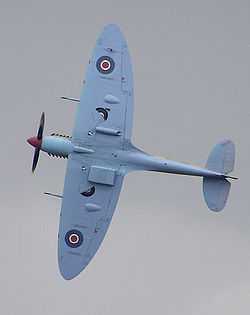Elliptical wing
Not to be confused with annular wings, which may be elliptically shaped

An elliptical wing is a wing planform shape that minimizes induced drag.[1] Elliptical taper shortens the chord near the wingtips in such a way that all parts of the wing experience equivalent downwash, and lift at the wing tips is essentially zero, improving aerodynamic efficiency due to a greater Oswald efficiency number in the induced drag equation.
The elliptical wing was first used on aircraft in the 1920s, [see Bäumer B II "Sausewind" of 1925] but has only seen limited use, for a number of reasons:
- the compound curves involved are difficult and costly to manufacture,
- the pure elliptical shape as a superior planform may be a myth.[2] A truncated ellipse, same span, same area, has, for all practical purposes, the same induced drag. Trapeze planforms with 0.4 or 0.5 taper ratio are induced drag equivalent, too.
- furthermore, the wing's uniform lift distribution causes the entire span of the wing to stall simultaneously, potentially causing loss of control with little warning. To compensate, aircraft such as the Supermarine Spitfire used a modified elliptical wing with washout, though such compromises increase induced drag and reduce a wing’s efficiency. Note, though, that the typical tapered wing planform has to employ more washout than the elliptical planform wing to see similar stall performance, which puts the tapered wing at a disadvantage.
Few aircraft have used elliptical wings, and even fewer have seen mass production, most in the 1950s and 60s. The British Supermarine Schneider Trophy racers of the early and mid-1920s were some of the most successful designs, and were the predecessors to the later Spitfire fighters. The German Heinkel He 70 of the early 1930s was a fast mail plane and reconnaissance bomber, and the predecessor to the Heinkel He 111 bomber, early models of which used an elliptical wing. Almost all of the United States Republic P-47 Thunderbolts used elliptical wings, except the last models, which used squared-off wingtips. In addition, several contemporary aircraft used a more conventional wing with elliptical wingtips in an attempt to gain some benefits without the added cost, but the aerodynamic benefit was found to be minimal.
The British Aircraft company Swift Aircraft are currently developing a two-seater Very Light Aircraft, Light-sport aircraft and CS-23 category Aircraft, the Swift Aircraft Swift, featuring elliptical wings.
References
- Clancy, L.J. (1975), Aerodynamics, Pitman Publishing Limited, London ISBN 0-273-01120-0
- McCormick, Barnes W. (1979), Aerodynamics, Aeronautics, and Flight Mechanics, pp 135–139, John Wiley & Sons, New York, ISBN 0-471-03032-5
- Milne-Thomson, L.M. (1966, 1973), Theoretical Aerodynamics, 4th Ed., Dover Publications Inc, New York. ISBN 0-486-61980-X. pp 208–209